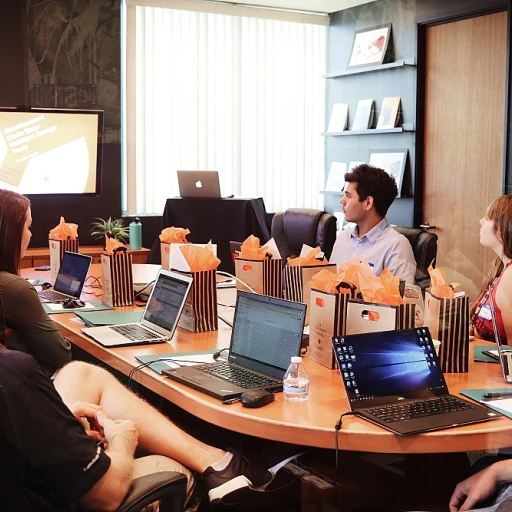
Understanding the Importance of Employee Engagement
The Role of Engagement in Employee Retention
In today's competitive job market, understanding the importance of employee engagement is crucial for any organization aiming to retain top talent. Employee engagement is not just a buzzword; it's a vital component of a successful business strategy. Engaged employees are more productive, provide better customer service, and are less likely to leave their jobs. This directly impacts the bottom line and enhances the overall brand experience.
Engagement strategies are essential for creating a work environment where employees feel valued and motivated. These strategies can range from personalized engagement approaches to leveraging technology for real-time feedback. The goal is to create a culture where employees are not just satisfied but truly engaged in their work.
Engagement's Impact on Business Outcomes
When employees are engaged, they are more likely to contribute positively to the customer journey and improve the customer experience. This is because engaged employees are more aligned with the company's goals and are more committed to delivering exceptional service. In turn, this leads to higher customer satisfaction and loyalty, which are critical for long-term business success.
Moreover, engagement efforts can lead to innovation and creativity within teams. When team members feel heard and valued, they are more likely to share ideas and collaborate effectively. This can result in improved products and services, enhancing the overall user engagement and product experience.
Building a Foundation for Engagement
To effectively engage employees, organizations need to identify key drivers of engagement. This involves understanding what motivates employees and what barriers might exist to their engagement. By using data-driven insights and feedback, companies can tailor their engagement techniques to meet the specific needs of their workforce.
Creating a culture of continuous feedback is another critical component of effective engagement. Regular feedback helps employees understand their performance and areas for improvement, fostering a sense of growth and development. This can be facilitated through various tools and platforms, including virtual meetings and social media, to ensure that feedback is timely and relevant.
Ultimately, mastering employee retention through innovative engagement strategies requires a commitment to understanding and meeting the needs of employees. By doing so, organizations can create a thriving work environment that not only retains talent but also drives business success.
Identifying Key Drivers of Engagement
Exploring Primary Factors Influencing Engagement
Understanding the factors that drive employee engagement is critical to developing effective strategies. While a variety of elements can impact engagement levels, identifying and focusing on key drivers can lead to successful engagement techniques.- Purpose and Meaning: Employees who see the value and impact of their work are more likely to remain engaged. Organizations should ensure that their team members perceive their roles as meaningful and aligned with the company's broader mission. This connection enhances both employee and customer engagement, contributing to a positive brand experience.
- Professional Growth Opportunities: Providing opportunities for learning and development is essential for maintaining high engagement levels. Employees who have access to continuous learning are more likely to feel valued and motivated. Leveraging advanced engagement tools and virtual meetings can facilitate training and development, enhancing the overall employee engagement strategy.
- Work Environment and Culture: A supportive and inclusive work culture can significantly enhance engagement. Employers should create a culture where feedback is encouraged and valued. Cultivating an environment that promotes honest communication and stakeholder engagement can lead to improvements in both employee and customer experiences.
- Recognition and Rewards: Recognizing and appreciating employees for their contributions plays a pivotal role in engagement. A well-implemented recognition strategy can lead to a more motivated workforce. This, in turn, influences user and customer journeys positively, as satisfied employees often deliver better customer service and product experiences.
- Autonomy and Flexibility: Allowing employees some level of autonomy over their work can bolster engagement efforts. Flexible working arrangements, including remote work options, empower employees to balance work-life successfully, enhancing overall engagement and satisfaction.
Implementing Personalized Engagement Approaches
Crafting Tailored Engagement Approaches for Lasting Impact
Employee retention hinges not just on strategies imposed from the top but on personalized engagement approaches that resonate with the unique needs of individual team members. In today's dynamic work environment, understanding and addressing these personal preferences can be the key to fostering motivation and loyalty. Recognizing that a one-size-fits-all strategy rarely works, consider the following approaches:- Flexible Work Arrangements: Allowing employees the flexibility to manage their work-life balance can enhance both engagement and satisfaction. It reflects a commitment to individual needs and can improve the overall employee experience.
- Customized Development Plans: Tailor learning and development opportunities to align with each employee's career aspirations. By investing in personalized career paths, organizations can nurture talent and build a stronger, more capable team.
- Advanced Engagement Tools: Utilize data-driven tools to understand employee sentiments in real time. These insights can inform strategies that align with personal interests and job satisfaction, creating a more engaged workforce.
- Social Media Integration: Foster a sense of community by encouraging connection through social media platforms. By promoting transparent communication and sharing content that resonates with employees, brands can enhance both user engagement and employee loyalty.
Leveraging Technology for Enhanced Engagement
Integrating Technology to Boost Employee Engagement
In today's digital age, leveraging technology is crucial for enhancing employee engagement. As organizations strive to create a more connected and motivated workforce, the right tools can make a significant difference. Here’s how technology can be a game-changer in your engagement strategy:
- Virtual Meetings and Collaboration Tools: With the rise of remote work, virtual meetings have become a staple. Platforms that facilitate seamless communication and collaboration among team members are essential. These tools not only help maintain productivity but also foster a sense of belonging among employees, enhancing their overall work experience.
- Data-Driven Insights: Utilizing data analytics can provide valuable insights into employee engagement levels. By analyzing feedback and engagement metrics, organizations can identify trends and areas for improvement. This data-driven approach allows for more targeted and effective engagement strategies.
- Social Media and Internal Networks: Encouraging the use of social media and internal communication networks can enhance employee interaction and engagement. These platforms allow for real-time feedback and foster a sense of community, which is vital for maintaining high levels of engagement.
- Learning and Development Platforms: Offering employees opportunities for continuous learning through online courses and training programs can significantly boost engagement. These platforms not only enhance skills but also demonstrate the organization's commitment to employee growth, which is a key driver of engagement.
- Advanced Engagement Techniques: Implementing advanced engagement techniques such as gamification can make work more enjoyable and engaging. By incorporating elements of game design into the workplace, organizations can motivate employees and enhance their overall experience.
By integrating these technological tools and strategies, organizations can create a more engaging and productive work environment. This not only benefits employees but also enhances the overall brand and customer experience, as engaged employees are more likely to deliver exceptional service.
Creating a Culture of Continuous Feedback
Nurturing an Environment that Rewards Constructive Feedback
In a rapidly evolving work environment, providing continuous feedback has become a cornerstone for enhancing employee engagement. The effectiveness of your employee engagement strategies is significantly influenced by the ability to create a culture where feedback is not only welcomed but actively sought. By fostering open communication, companies can strengthen their brand, improve products, and refine strategies.
To encourage feedback, consider these key components:
- Leverage Technology: Utilize digital tools to facilitate real-time feedback channels. This not only aids in capturing immediate reactions but also promotes a dynamic feedback loop that can be analyzed for data-driven decisions.
- Ensure Diverse Channels: Create multiple avenues for feedback—virtual meetings, social media interaction, or dedicated feedback sessions—to ensure all team members can express their thoughts. This holistic approach enhances employee and user engagement and captures a broader scope of insights.
- Incorporate Customer Insights: Just as customer feedback is pivotal for advancing the customer journey and experience, it also informs employee engagement efforts. Cross-referencing employee and customer feedback can lead to holistic, proof-based enhancements.
- Promote Learning: Feedback should be a learning tool rather than just a performance metric. Encourage employees to view feedback sessions as opportunities for growth, aligning with the broader objective of continuous personal and professional development.
The success of your engagement techniques relies heavily on the smooth integration of feedback into the broader company strategy. Not only does effective feedback draw a clearer picture of operational efficacy, but it also amplifies the employee's role in driving the company’s objectives. When employees see their feedback impacting real change, their commitment and satisfaction naturally increase, resulting in enhanced customer experience and loyalty.
Measuring the Impact of Engagement Strategies
Examining the Results of Your Engagement Techniques
Once you have implemented various engagement strategies, the next step is to measure their effectiveness. It's crucial to understand how these actions impact employee engagement and the overall workplace atmosphere. Data-driven insights can guide future initiatives and refine your approach.
One effective way to assess the success of your engagement efforts is by analyzing real-time feedback from employees. Tools that facilitate continuous feedback loops allow team members to express their thoughts promptly. This not only enhances employee engagement but also fosters a culture of transparency and trust.
You can also measure engagement by evaluating key performance indicators (KPIs) linked to your strategy. These indicators might include employee retention rates, customer satisfaction scores, and productivity metrics. By aligning these KPIs with your company’s goals, you stand a better chance of advancing your brand’s mission while ensuring an effective customer and employee experience.
Using technology such as data analytics platforms can significantly aid in analyzing feedback and user engagement trends. Social media analytics, for example, may offer insights into employee interactions and stakeholder engagement in your brand's online presence.
For a comprehensive understanding of the engagement journey, consider leveraging data from diverse sources. Whether it's employee surveys, virtual meetings feedback, or customer feedback, gathering a wide range of information provides a more holistic view of how your strategies are resonating.
Ultimately, refining your engagement techniques should be an ongoing process. As workplace dynamics and market conditions evolve, staying adaptable and responsive will help maintain a positive product experience for both employees and customers. Implementing a consistent analysis framework will ensure that your engagement strategy remains aligned with the company's overarching goals, cultivating an enriching work environment and a seamless customer journey.












